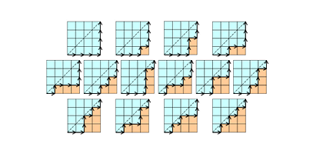Is this a coincidence too?
 If we write out the decimal expansion of the smaller root of
f
(
x
)
=
1
0
0
0
0
0
0
x
2
−
1
0
0
0
0
0
0
x
+
1
, we get the following decimal:
0
.
0
0
0
0
0
1
0
0
0
0
0
1
0
0
0
0
0
2
0
0
0
0
0
5
0
0
0
0
1
4
…
which we notice as the first 5 Catalan numbers. How many distinct Catalan numbers occur in a row before this pattern stops?
If we write out the decimal expansion of the smaller root of
f
(
x
)
=
1
0
0
0
0
0
0
x
2
−
1
0
0
0
0
0
0
x
+
1
, we get the following decimal:
0
.
0
0
0
0
0
1
0
0
0
0
0
1
0
0
0
0
0
2
0
0
0
0
0
5
0
0
0
0
1
4
…
which we notice as the first 5 Catalan numbers. How many distinct Catalan numbers occur in a row before this pattern stops?
Image Credit: Wikimedia Dmharvey .
The answer is 12.
This section requires Javascript.
You are seeing this because something didn't load right. We suggest you, (a) try
refreshing the page, (b) enabling javascript if it is disabled on your browser and,
finally, (c)
loading the
non-javascript version of this page
. We're sorry about the hassle.
2 solutions
Exactly what I had in mind, no need for me to write another solution.
If distinct means no zero between, l agree.
To prove the digits of C 1 , … , C 1 2 are unaffected by the rest of the sum. we must show k = 1 3 ∑ ∞ C k 1 0 − 6 ( k + 1 ) ∈ [ 0 ; 1 0 − 7 8 ) ( ∗ )
It is not enough to verify C 1 4 only overlaps with C 1 3 . Even if that were the case, the combined rest in ( ∗ ) could still grow big enough to influence any digit before - including those of C 1 , … , C 1 2 .
Rem.: Let's prove a sufficient upper estimate of the combined rest with a k : = C k 1 0 − 6 ( k + 1 ) and k ≥ 1 3 : ∣ ∣ ∣ ∣ a k a k + 1 ∣ ∣ ∣ ∣ k = 1 3 ∑ ∞ a k = ( k + 1 ) 2 1 0 6 ( 2 k + 2 ) ( 2 k + 1 ) = 1 0 6 4 ⋅ 2 k + 2 2 k + 1 < 1 0 6 4 < 9 1 = : q , < ∣ a 1 3 ∣ k = 1 3 ∑ ∞ q k − 1 3 = 1 − q ∣ a 1 3 ∣ = C 1 3 ⋅ 1 0 − 8 4 ⋅ 8 9 < 1 0 − 7 8 ■ ∣ a k ∣ ≤ ∣ a 1 3 ∣ q k − 1 3 ,
The Catalan numbers are given by C ( n ) = ( n + 1 ! ) n ! ( 2 n ) ! for n > = 0 and are 1 , 1 , 2 , 5 , 1 4 , 4 2 , 1 3 2 , 4 2 9 , 1 4 3 0 , 4 8 6 2 , 1 6 7 9 6 , 5 8 7 8 6 , 2 0 8 0 1 2 , 7 4 2 9 0 0 , 2 6 7 4 4 4 0 , 9 6 9 4 8 4 5 , . . .
The numberst start to overlap as soon as they get more than 6 digits, so that the leading 2 of 2 6 7 4 4 4 0 merges with the last digit of the 14th Catalan number C ( 1 3 ) = 7 4 2 9 0 0 into 7 4 2 9 0 2 (which then of course is not a Catalan number anymore).
Before that were 13 undistorted Catalan numbers, of which 1 2 are distinct.
It can undoubtedly be shown that in a Taylor expansion of x in 1 the Catalan numbers show up, but I considered it a given in this context.
We first start with a generating function with Catalan number coefficients
1 + 1 − 4 x 2 = n = 0 ∑ ∞ C n x n
which can be rewritten as
2 1 − 2 1 1 − a 4 = a 1 n = 0 ∑ ∞ ( a n C n )
The left side is one of the roots of the equation
a x 2 − a x + 1 = 0
and here, in this problem, a = 1 0 0 0 0 0 0
So, the distinct appearances of Catalan numbers ends when
C 1 4 = 2 6 7 4 4 4 0 > 1 0 0 0 0 0 0
runs into C 1 3 = 7 4 2 9 0 0 < 1 0 0 0 0 0 0
so that the answer is 1 2
It's a little surprising to see Catalan numbers pop out of such a simple equation.